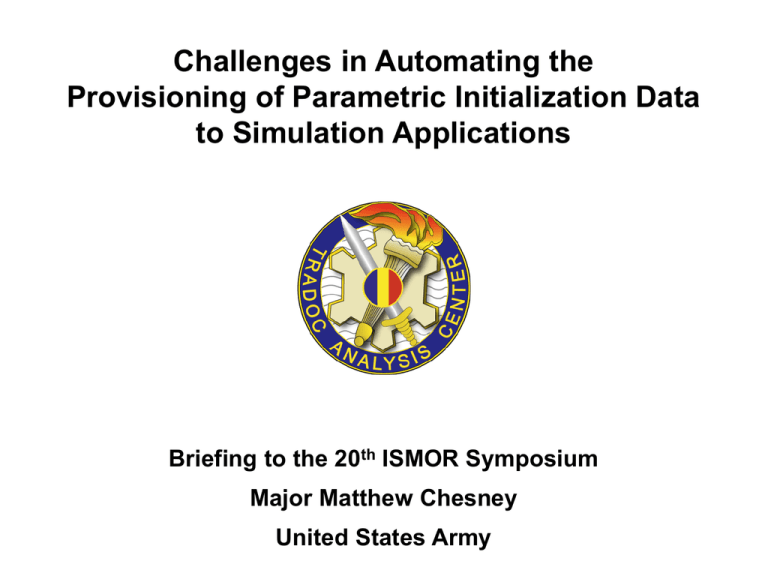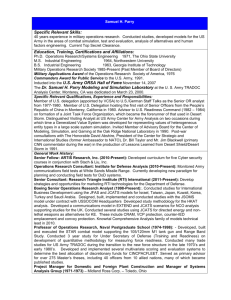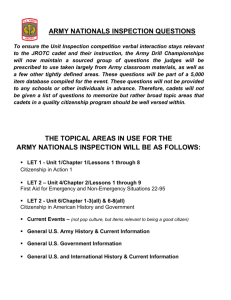the presentation
advertisement

Challenges in Automating the Provisioning of Parametric Initialization Data to Simulation Applications Briefing to the 20th ISMOR Symposium Major Matthew Chesney United States Army Agenda • Background – US Army’s Training and Doctrine Command Analysis Center (TRAC) • Equipment Characteristics and Performance Data Interchange Format (DIF) – The Background project to the paper • The Challenges and Recommendations – The Subject of our paper DYNAMICS RESEARCH CORPORATION TRAC-Monterey Overview TRAC Organization CG TRADOC Ass’t DCSSA Monroe COL Mitcham Director TRAC Mr. Bauman, Director COL Treharne, Deputy FLVN Established 1979 Monterey WSMR LEE Dr. Goodwin, Director LTC Wilson, Deputy JFCOM LTC Cioppa, Director Mr. Jackson, Deputy Ms. Winter MAJ Deller Fort Monroe Fort Lee Mr. Magee, Director COL Lee, Deputy Ms. Vargas, Director COL Appleget, Deputy MTRY Fort Leavenworth JFCOM White Sands Missile Range Centers of Expertise Ft Leavenworth Corps, Div, & Joint Operations WSMR Bde & Bn Ops, Training, Costs Ft Lee Logistics, Support & Sustain Monterey Research JFCOM Joint Experimentation Overview TRAC-Monterey Research Pillars MOUT Modeling and Simulation Advancements in simulation and OR Methodologies Elements of Combat Power Overview Advancements in Simulation and OR Methodologies • Natural Decision-Making and Information Fusion - To represent how decisions are made for use in simulations • Agent-Based Modeling - Determine potential for US Army; Application for DBBL • Experimental Design - Most information from fewest number of runs • JANUS vs. JCATS Attrition Algorithms - Comparison of Algorithms in Urban Environment • Extensible M&S Framework - ‘Next Generation’ simulation architecture • Characteristics and Performance Data Exchange Using XML - Reduce data manipulation requirements • OneSAF / COMBATXXI Research Lab - Opportunities to leverage multiple efforts and organizations • Acquisition Management Institute Initiative - Instantiate SMART in practice through focused research / education Overview TRAC-Monterey Partnerships Military •Army Modeling and Simulation Office •Army Aviation and Missile Defense Command •Army Aviation Center •Army Depth & Simultaneous Attack Battle Lab •Army Infantry Center •Army Simulation, Training, and Instrumentation Command •Air Force Training and Evaluation Command •Engineer Research and Development Center •Army Accessions Command •PM Soldier •TPO OneSAF •Army Material Systems Analysis Activity (AMSAA) •TRAC-FLVN •TRAC-WSMR Academia NPS: •Computer Science •Engineering Management •Mathematics •Mechanical Engineering •Operations Analysis •Software Engineering •Systems Engineering TRAC-Monterey USMA •Systems Engineering Contractors •Rolands and Associates, Inc. •Dynamics Research Corporation •Tapestry Solutions, Inc. •NovaLogic Systems •Wexford Group Overview Background AR 5-11; “Management of Army Models and Simulations: • Share valid data to all M&S data consumers • Develop Standards to use common data • Minimize Cost of Data • • • • State of the practice Data management Higher resolution model support Data interchange formats Overview Current Data Exchange Methodology Overview Data Interchange Formats Overview Project Milestones Consumer Data Requirements Analyze Consumer Data Requirements Provider Formats Data Requirements Assess Providers Formats Producer Formats Extend and Document XML Data Standard FY01 Data Standard Manage Project FY02 Data Standard Final Report Demo Results Demonstrate DIF Use Sample Producer Data Sample Consumer Data Demonstration Tool Legend Develop User Interface Control / Constraint Input Activity Output XML Spy IDE Mechanism Overview FY02 Providers/Consumers Authoritative Data Providers XML Populated DIF (XPOD) Consuming Simulation Systems OTB Reader Files OTB Import Routines AMSAA Export Routines DIMSRR SPIRIT Databases C&P Data populated into XML DIF Standard <?xml version=“1.0”?> <EquipmentCPData> <tag>data</tag> </EquipmentCPData> OOS KA/KE Repository OOS Conversion Routines NGIC Export Routines Combat XXI Import Routines Combat XXI Legacy Formats Overview Scope The FY01 scope was: • Ground systems and direct fire The FY02 effort expands the scope to include: • Indirect Fire systems, • Communication systems, • Sensor systems (i.e., Radar, IR, Day vision, and NVG systems), and • Aircraft (i.e., fixed wing, rotary wing, and UAVs) Overview DIF Implementation Challenges and Potential Solutions • Semantic Interoperability, • Semantic Mapping Responsibility, • Explicit Tags vs. Meta-model Approach, • Standard Nomenclature, • Entity Type Enumerations, • Versioning / Traceability, • Storage Methods, • Distribution Methods, and • Standards Development Process Overview Semantic Interoperability • Challenge: although XML can help solve syntactic interoperability challenges, differences in producer and consumer semantics (the meaning of the data) must be addressed in other ways. • Proposed solution: standardizing on data models and providing explicit semantics. Overview Semantic Mapping Responsibility • Challenge: although a DIF provides a standard data format, both producers and consumers will likely require a mapping process to translate their data to/from their data models into the DIF’s semantics. • Proposed solution: decisions must be made regarding whether to delegate transformation requirements to the producer or the consumer. Overview Explicit Tags vs. Meta-model Approach • Challenge: • Explicit DIFs use tag names that contain the identifier of the data value being passed • The meta-model approach involves using a single tag name and passing the data value identifiers as text string data • Proposed Solution: Compromise; embed explicit tags only when necessary in a Meta Model <parameter> <name>weight</name> <weight>18</weight> <value>18</value> </parameter> Overview Standard Nomenclature • Challenge: common naming is a significant, yet easily solved challenge in sharing simulation data. A variety of schemes are available • Proposed solution: army’s standard nomenclature database (SND) for equipment and munition naming used by army analytical community in support of army studies and the DMSO common semantics and syntax effort for other parametric descriptions Overview Entity Type Enumerations • Challenge: assignment of unique identifiers to simulation object types • Proposed solution: Modernized Integrated Data Base (MIDB) over the IEEE Distributed Interactive Simulation Enumeration Overview Versioning / Traceability • Challenge: pedigree or provenance of the data is especially important to verification and validation agents • Proposed Solution: provide metadata with the data that indicates the version and pedigree of the data. The metadata may be needed down to the individual data items level Overview Storage Methods • Challenge: large file sizes and classification levels • Proposed solution: Physical storage not a huge limiter but using short tag names, using tabs instead of spaces, limiting embedded comments, using explicit DIFs, and subdividing documents will help Overview Distribution Methods • Challenge: distributing data • Proposed solution: • Immediate solution is to use web portals that use human intervention. • The future vision is to enable web services that automatically respond to consuming software requests for data. The goal should be to decrease the amount of human intervention. Included services should be able to check the version of data and update the data where needed Overview Standardization Process • Challenge: standards; Interoperability ontology and other agreements must be developed in a collaborative environment with input from various interests and compromises on the approach. • Proposed solution: SISO and other industry groups develop and document standards. Develop Recommended Practice Document As defined by AR 5-11, Data Standards is: “A capability that increases information sharing effectiveness by establishing standardization of data elements, data base construction, accessibility procedures, system communication, data maintenance and control.” Overview Summary • Semantic interoperability Provide explicit semantics • Semantic mapping responsibility Decision: Consumer or Producer • Explicit tags vs. Meta-model approach, Compromise; combined data model • Standard nomenclature • Entity type enumerations SND and DMSO common semantics • Versioning / Traceability MIDB before IEEE • Storage methods Provide archive info meta data • Distribution methods • Standards development process Limit tag names, spaces and comments Web Services SISO Overview Questions? Overview



